This post may contain affiliate links. Please read our disclosure policy.
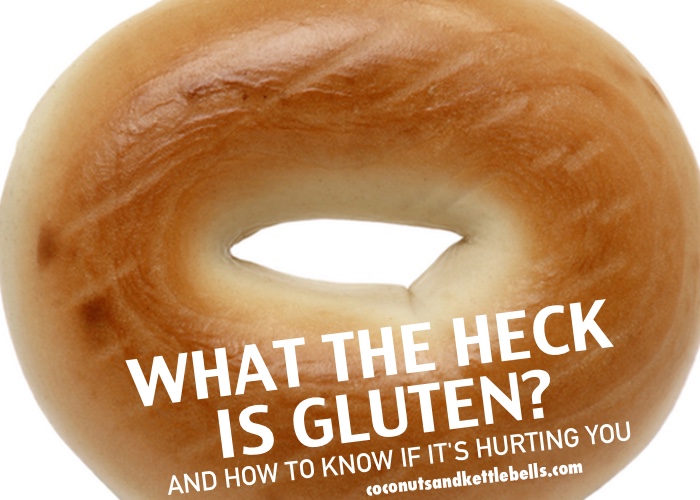
Gluten free is rad. Wheat is bad.
Or something like that. Even if you’d admit to not knowing anything about gluten, you’ve definitely heard of it by now. Grocery stores have sections dedicated to it, celebs are proclaiming their love for being free of it, and many restaurants have “gluten free” labeled right on the menu. In 2012, gluten free products totaled $12.4 BILLION in sales, an 18% increase in the previous year.
Despite all the attention, most people, whether choosing to avoid gluten entirely or ingest it freely wouldn’t be able to answer the question “What is gluten?” Popular insufficient assumptions include:
…bread, grains, carbs, starch, cheez-its, sugar, bad stuff, baked goods, noodles, cupcakes, calories and yummmmy.
And all those are close. Well, sort-of. OK, technically… not really at all.
Jump to:
What is Gluten?
Gluten is the term used to refer to a combination of proteins found in certain grains. As you may know, the grain is actually the seed (aka the reproductive force) of a plant. This seed is made up of three parts: the endosperm (inside), the bran (outer shell), and the germ (nutrient “core.”) Enter: “Bill Nye the Science Guy” Theme Song. Gluten is located in the endosperm. When we eat “whole grains,” we’re eating all three parts of the seed. When we eat “refined grains,” we’re eating just the endosperm (the bran and germ are removed.) Don’t be fooled though, most all packaged grain products, whether “whole” or not, are highly refined and processed.
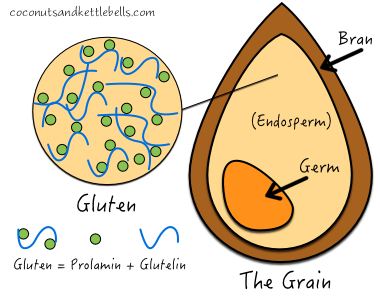
Getting into a bit more specifics, gluten is a mixture of two types of proteins: prolamin proteins and glutelin proteins (see helpful diagram above!) Although most grains contain a mixture of prolamin and glutelin proteins, the specific combination in wheat, barley and rye is what is now generally used to define what is gluten.
Gluten containing grains include: Wheat, Barley, and Rye, and related grains including Bulgur, Malt, Spelt, Oats (severely problematic for some), Kamut, Semolina, Durum, Pumpernickel, Farro, and Triticale.
“Gluten free” grains have prolamins and glutelins protein complexes that have different amino acid chains (remember: proteins are broken down into amino acids in the body) that generally don’t cause the same level of disruption as those classified as “gluten.”
Gluten free grains include: Amaranth, Rice, Corn, Buckwheat, Teff, Amaranth, Quinoa, and Millet.
Why Gluten Sucks (for some)
Until recently, doctors and scientists have thought of gluten as only causing problems to those suffering from an autoimmune condition called Celiac Disease. When people with Celiac Disease (CD) eat gluten, it triggers a cascade of inflammation both outside and inside the intestinal wall, and loosening of the tight junctions that hold the cells of our gut together.1
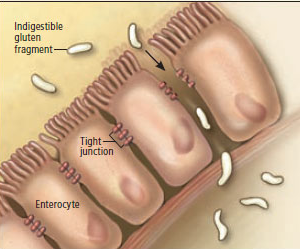
When this loosening occurs, undigested gluten proteins “leak” through the gut barrier and interact with something called Tissue Transglutaminas (tTG), an enzyme the body releases in the gut to help repair damage. Because the invaders (gluten) are now crosslinked with the body’s own tissue (tTG), the immune system creates antibodies to attack both the gluten and gut cells (called enterocytes.)
If that sounds bad, it is. Basically, the intestinal wall gets attacked viciously and goes up in flames. If left untreated, CD can lead to serious vitamin and nutrient deficiencies, the development of other diseases and autoimmune conditions (Rheumatoid Arthritis, Type 1 Diabetes, Hashimoto’s, etc.), and nasty systemic gut inflammation which is linked to all different types of cancers and early death.
So, I don’t have Celia-whatever… that means I can eat lots of bread, right?!
Well, the research is showing a much different story.2
First, you may assume you don’t have Celiac Disease because you don’t experience digestive related issues. In reality, only 50% of those newly diagnosed with Celiacs Disease actually experience gut related symptoms. It’s estimated that 1 in 133 people suffer from Celiac Disease, and that for every one person diagnosed with Celiac Disease, there are 6.4 people undiagnosed.[3][4] The truth of the matter is, only 1 in 4,700 have actually received an official diagnosis, meaning millions with Celiac Disease are unaware of it. That’s downright scary.
So, if you’ve been diagnosed with depression, thyroid issues, osteoporosis, migraines, or lymphoma (yeah, cancer SUCKS), it could be because of untreated Celiac Disease.
In the last few years, it’s also become clear that Celiac Disease is only one of many expressions of gluten intolerance. A general “sensitivity” to gluten which many people experience is now recognized as Non-Celiac Gluten Sensitivity (NCGS.) Hooray for simple, easy names! Those with NCGS experience the same symptoms as those with Celiac Disease or a wheat allergy, but they don’t produce antibodies to their body’s own tissue, or have the same severe intestinal atrophy.
Well dang. How do I know if I have gluten this “sensitivity”… and why should I care? I want bread.
We’re almost there. Pinky swear!
If you have Non-Celiac Gluten Sensitivity, gluten is still causing an immune reaction in your gut in response to gluten (serious gut inflammation you can’t even feel), and can still lead to leaky gut.5 Not only that, when your immune system is working overtime against gluten, it doesn’t work so well in other parts of your body – like fighting damage from a workout, work related stress, or a virus that’s making you sick.
Here’s the real kicker. Just like Celiac Disease, Non-Celiac Gluten Sensitivity can affect virtually any tissue in the body from the brain to the liver, and has been associated with causing an astounding amount of symptoms and diseases, the most common being IBS-like symptoms (abdominal pain, bloating, diarrhea, and constipation), brain fog, headaches, migraines, fatigue, joint and muscle pain, leg or arm numbness, dermatitis (eczema or skin rash), depression, anxiety, and anemia. It’s also been associated with neurological and psychiatric conditions such as ADHD.
And the most fascinating to me, gluten intolerance is being associated with a number of endocrine related issues – including infertility and thyroid issues.[6][7]
Experts in the field of gluten intolerance estimate that 7 – 30% of the population are suffering from Non-Celiac Gluten Sensitivity. Dr. Rodney Ford, a pediatric gastroenterologist and allergist in New Zealand says he believes that percentage could actually be much higher, up to 50% of the population. Dr. Kenneth Fine, gastroenterologist and internationally known medical researcher has also stated that gluten sensitivity could very well affect as much as half of the population.
It’s important to note – for NCGS, there is no official diagnostic test or medically defined set of symptoms. We’ve only just begun to learn about gluten intolerance and how it can affect the body, and much is being discovered as we speak from incredible pioneering researchers like Dr. Alessio Fasano.
So how the HECK am I supposed to know if my migraines are because of gluten?!
PIECE OH CAKE. Or, lack there of.
It’s time for a gluten challenge. Go without gluten for 30-60 days, depending on the severity of your issues. See how you look, feel and how your body performs. Do your migraines go away? Do you get your period again? Does your depression “lift?” Does your gas, bloating, and IBS disappear?
After your challenge, introduce gluten again and see how you feel. You get to make the decision about what works for you and what makes you feel your best.
Gluten-free Does Not Equal Healthy
Droppin’ a truth bomb: Gluten-free products are 242% more expensive than “gluten” ones, and usually still contain garbage ingredients. Check out the cocktail in this popular brand’s “Omega Flax & Fiber” Gluten-free Bread:
WATER, TAPIOCA STARCH, BROWN RICE FLOUR, EGG WHITES, RESISTANT CORN STARCH, NON-GMO VEGETABLE OIL (CANOLA OR SUNFLOWER OR SAFFLOWER), FLAX SEED, CANE SYRUP, CHIA SEED, YEAST, ORGANIC INULIN, CITRUS FIBER, EVAPORATED CANE JUICE, RICE BRAN, SALT, PEA PROTEIN, DRY MOLASSES, XANTHAN GUM, SODIUM ALGINATE, GUAR GUM, CARRAGEENAN, LOCUST BEAN GUM, SODIUM CARBOXYMETHYL CELLULOSE, CULTURED CORN SYRUP SOLIDS, ENZYMES.
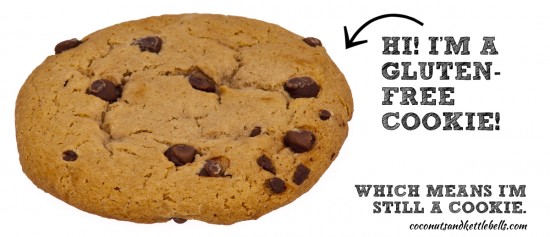
5 different type of “gums”, 3 different types of sugar, vegetable oil, and GMO corn and rice. That doesn’t quite resemble human food.
My point? Gluten-free junk food is still junk food. I’m not against having “treats” like this occasionally, but don’t be misinformed and think that just because it’s gluten-free, it’s health-promoting. A packaged gluten-free muffin, cookie, or marshmallow cereal bar is still a muffin, cookie and marshmallow cereal bar. Processed sugars, non-gluten grains, vegetable oils, and food additives can cause gut disruption, inflammation and will inhibit your gut restoration.
Gluten-free is Not Low-Carb
Rest assured, a gluten-free lifestyle is not a low-carb lifestyle. Those who choose to eliminate gluten laden foods can get plenty of carbs from fruits and vegetable matter, including starchy roots and tubers like sweet potatoes and squash to meet even the most active of lifestyles. Also, other grains like rice, while potentially still problematic for some, can be soaked and consumed without any ill-effects.
In short, by eliminating processed junk like bars, bagels, breads and pastas, you eliminate the overconsumption of carbohydrate and sugar that’s become part of the modern Standard-American Diet. Not only that, but your vitamins, minerals, and fiber intake with soar through the roof.
Want to take your gluten challenge a step further? Try a Whole30 which eliminates many potentially allergenic foods for a 30-day period.
What improvements did you see by going gluten-free? Testimonials will help others understand the potential improvements they could see from a gluten-free lifestyle, so don’t be shy!
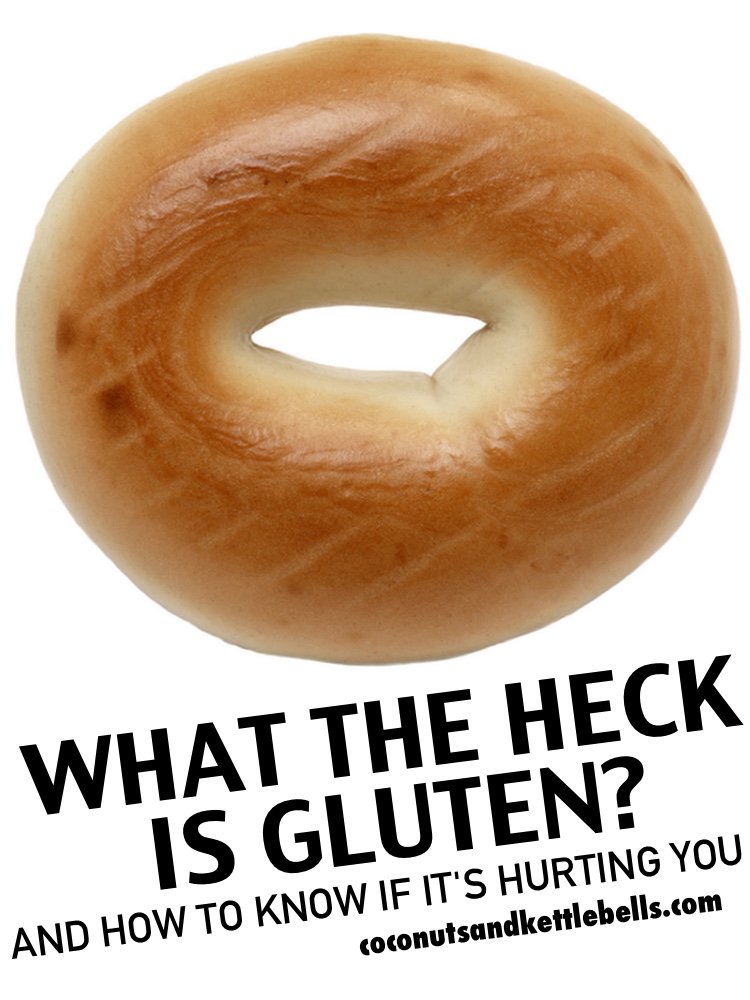
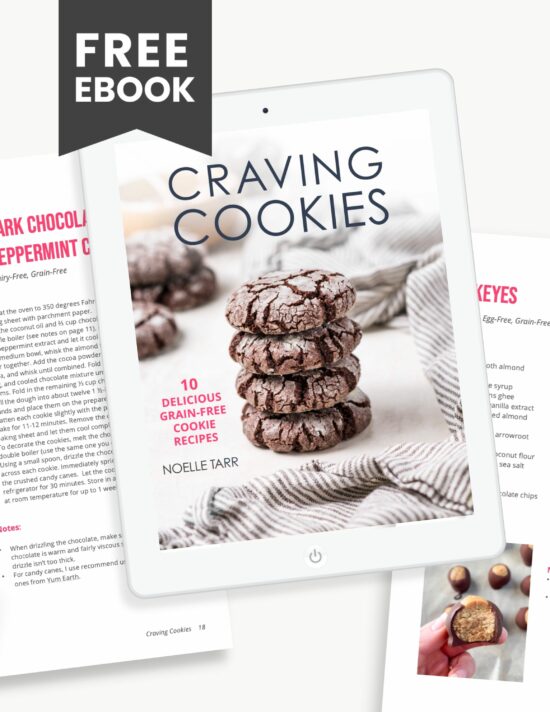
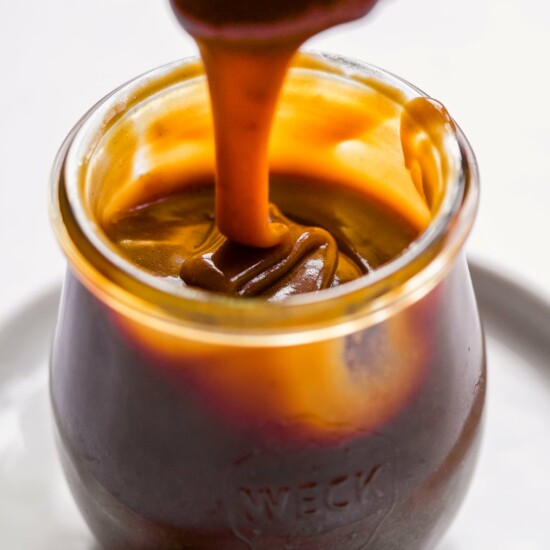
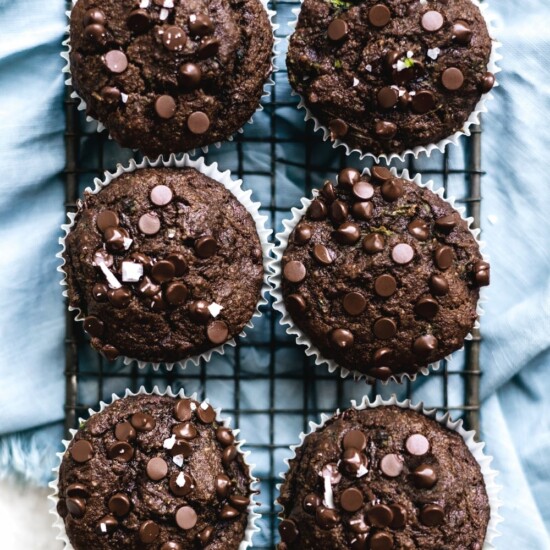
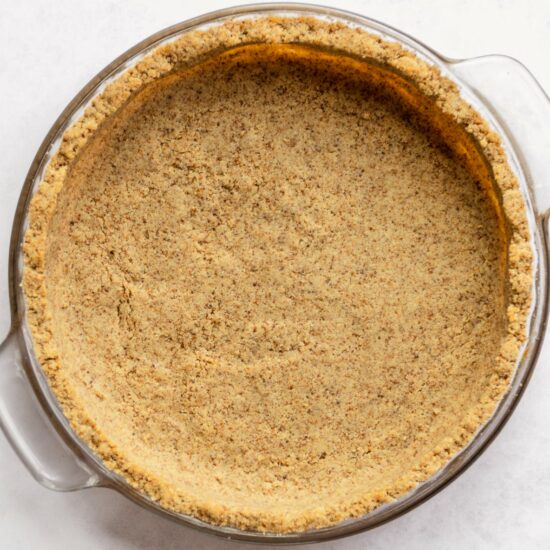
Sarah @ Sensibly Sustainable says
This is the best article I’ve seen on gluten! Clear cut, easy for “simple folks” like me to understand! Well done 🙂 Thanks for the info and the encouragement to truly try gluten-free!
Noelle says
Sarah – awesome! So glad it was easy to read – that’s my goal! 🙂 Thanks so much for your support!
Vernon says
Great article!!!! I suspect i’m suffering from gluten allergy. I got hives on my skin on and off for 2 days consecutively after eating a burger with gluten grains on the bread. With this article, my long list of suspicious substances has been narrowed down. Now i’m 90% sure my hypersensitively is caused by this gluten thing. I will go gluten-free for 30days and report my results here. Once again thanks for putting this together. Simple to understand and concise.
Noelle says
Vernon, that’s awesome. I’d love to see the results and how it goes. Thanks for your support – love hearing from you guys!
Adrienne @ Whole New Mom says
GREAT post!!!
Noelle says
Thank you Adrienne!! 🙂
retha says
Hi, i have just read your article and found it very helpful and understand gluten much better now. My problem is that i have an underactive thyroid and i slso suffer from fibromyalgea. I also have osteoarthritus in my lower back shoulder and neck. I am in constant pain. Do you think this could tie up with gluten sensitivity? Thank you
Noelle says
Retha! So glad it helped. If you’re dealing with hypothyroidism, I would 100% recommend removing gluten for at least a month and seeing how you feel. There is a lot of research that shows there is a strong connection with hypothyroidism (and Hashimoto’s) and gluten intolerance. If you can, I’d also recommend removing dairy, as that can be a catalyst for inflammation associated with osteoarthritis. For help with your thyroid issues, I think you’d find this book incredibly helpful: Why Do I Still Have Thyroid Symptoms? When My Lab Tests Are Normal. Hope that gives you some insight!
Ayesha says
The whole30 link is inactive. 🙁
Nice blog… I came here to check your DIY ACV toner and end up checking all other posts… 🙂
Anyway, do you have a recommended diet to go 30 or 60 days gluten free? I think I may have intolerance to gluten & lactose. I wanna try elimination diet as much as I can cause I seem to be very gassy no matter what I eat. When I tried that banana island diet for 4 days, I was feeling good.. No flatulence whatsoever so that’s why I’m trying to see what food or food groups are bad for me and hopefully cure me. Thanks.
Noelle says
Hi Ayesha! I would recommend just eliminating both gluten and milk for 30 days, and then reintroducing them each one at a time. Check out http://www.whole30.com for more information about that as an elimination diet. 🙂 Thanks for your question – and support!
Holly Maree says
Hi Noelle! Thanks for such a great article. I decided last year to experiment with cutting gluten from my diet due to horrible bloating I was feeling on a continuous basis. I feel so much better for it and I don’t really feel like I miss out as I love quinoa and I can manage oats (luckily). I also found I can eat sprouted rye and esikiel bread and small amounts of spelt. I have received a my of backlash though from friends and family though saying that I have just jumped on the trend and because I don’t have an official diagnosis I have no validated reason to go gluten free. Thank you for writing this article because now I can show them the facts and explain gluten sensitivity to them in a way I previously didn’t know how to!
Noelle says
So glad it helped, Holly! In the end, just do what works best for you. If friends and family give you a hard time, I would suggest just letting them know that it makes you feel better, and that’s that. No need to discuss food as “good” or “bad” – or compare each others diets. Thanks for your support!
Kayleigh says
Loved this article!
Like some of the others here, I don’t have an official diagnosis, but had heard whisperings that the KP I have on my arms could be an outward sign of inflammation in my body caused by gluten sensitivity. I was skeptical, but thought I’d test the waters anyway. My KP is hanging around, but one of the most notable changes I’ve experienced is that my chronic heartburn (or, what I assumed was heartburn) is totally gone. As in, I’ve been suffering for years and poof, in less than weeks, adios.
What has really solidified in my mind that it is indeed a gluten sensitivity, is that when I have reintroduced gluten products, I suffer big time. Not just once because I ate something spicy, or because I had cooked tomatoes, but every single time, it’s the same raging stomach ache waking me up at 5 in the morning.
So…I guess I’m sold.
Kayleigh says
Ha…less than 6 weeks! :p
Noelle says
Awesome! Your experience is like so many others! Can’t go wrong with doing what works best for you, and eating the foods that make you feel well! 🙂
Bettina says
Very interesting and informative. I have several of the symptoms highlighted, which leads me to believe I should take a break from gluten for 30 days as suggested and see if I am more energetic. Just wondering whether gluten is only released when pasta is cooked or is it in the raw pasta? Sorry if that sounds like an odd question, but I am curious as to when gluten has an effect on people who are either allergic to wheat or who have been diagnosed as celiacs. I have been told by a health practitioner that I am intolerant to wheat, dairy and eggs, but I continue to eat all of these anyway as I enjoy them all. My main reaction to wheat appears to be fatigue, but I occasionally suffer from brain fog for sure, headaches and numbness in my fingers, but I think I have also developed eczema in the last year. Interested in your feedback. Thank you.
Noelle says
It’s in food whether cooked or not. Definite eliminate gluten for 30 days and see how you feel!